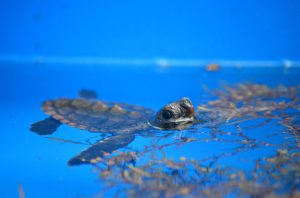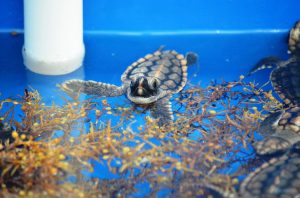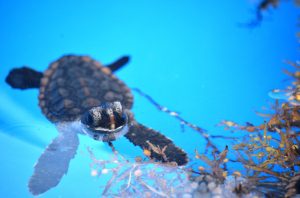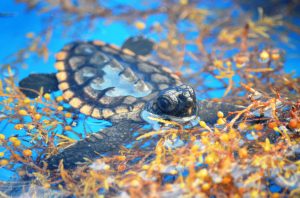 Sea turtle nesting season – the time of the year when you will come across bright yellow sea turtle nesting signs and stakes, tracks and possibly even sea turtle hatchlings along our local beaches. Since the hatchlings have started to emerge, Loggerhead Marinelife Center (LMC) has already received their first batch, with many more, up to 2,000, to follow. These hatchlings don’t make it into the ocean for many different reasons, including disorientation, entanglement, predation injuries and weakness. The hatchlings are typically found by LMC biologists while doing their daily, morning beach surveys and by local beach walkers. Disoriented hatchlings can be placed in the 24 hour drop-off cooler located outside of the entrance to the center.
Sea turtle nesting season – the time of the year when you will come across bright yellow sea turtle nesting signs and stakes, tracks and possibly even sea turtle hatchlings along our local beaches. Since the hatchlings have started to emerge, Loggerhead Marinelife Center (LMC) has already received their first batch, with many more, up to 2,000, to follow. These hatchlings don’t make it into the ocean for many different reasons, including disorientation, entanglement, predation injuries and weakness. The hatchlings are typically found by LMC biologists while doing their daily, morning beach surveys and by local beach walkers. Disoriented hatchlings can be placed in the 24 hour drop-off cooler located outside of the entrance to the center.
Upon arrival, the sea turtles are triaged and examined. It is then determined what their next step will be. If the hatchlings are strong or leatherbacks, they may be released from the beach early the next morning. A hatchling that is weak, injured or debilitated will remain in the hospital for treatment. When they are strong enough to swim, they will be placed in a viewable, outside tank at the center until arrangements are made to release them into the sargassum weed line. LMC is planning on releasing the hatchlings every two weeks. The weed line is located between 5-15 nautical miles away from the shore in the Gulf Stream. This floating sargassum is where these hatchlings live for the first several years of their lives. This weed line offers camouflage protection and is a primary food source for the hatchlings.
There are many ways that you can help aid in the rehabilitation and return of these sea turtle hatchlings to their ocean home. You can support sea turtle hatchlings by “adopting” them, which will provide much needed funds for their food, medicine and treatment. If you’re interested in adopting sea turtle hatchlings, please visit www.marinelife.org/adopt. You can also familiarize yourself with nesting season do’s and don’ts and become an ambassador for sea turtles and ocean conservation.
Do:
- Throw away foreign objects and debris left behind on the beach
- Fill in holes in the sand which may obstruct sea turtles and hatchlings paths to and from the ocean
- Observe a nesting sea turtle from a distance from behind
- Look out for disoriented hatchlings on trails and roads near the beach
- Keep your Lights Out near the beach or install sea turtle-friendly lighting
- Bring weak or confused hatchlings to LMC at 14200 US Highway One, Juno Beach, FL 33408
Don’t:
- Don’t interact with or disrupt a nesting sea turtle
- Don’t use lighting on the beach at night including flash photography, or cell phones
- Don’t touch hatchlings on their way to the ocean
- Don’t take any action for empty egg shells, or exposed, un-hatched eggs
- Don’t harm or harass sea turtles, their nests or hatchlings
- Don’t use shovels to dig on the beach during nesting season
While sea turtles are beautiful, captivating creatures, it is illegal to harm or harass sea turtles, their nests or hatchlings. Sea turtles are protected by the US Endangered Species Act of 1973 and Florida Statute Chapter 370.



